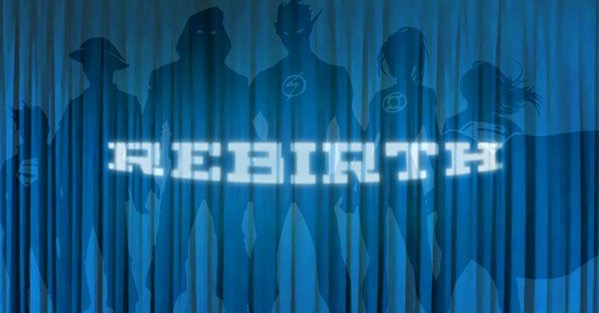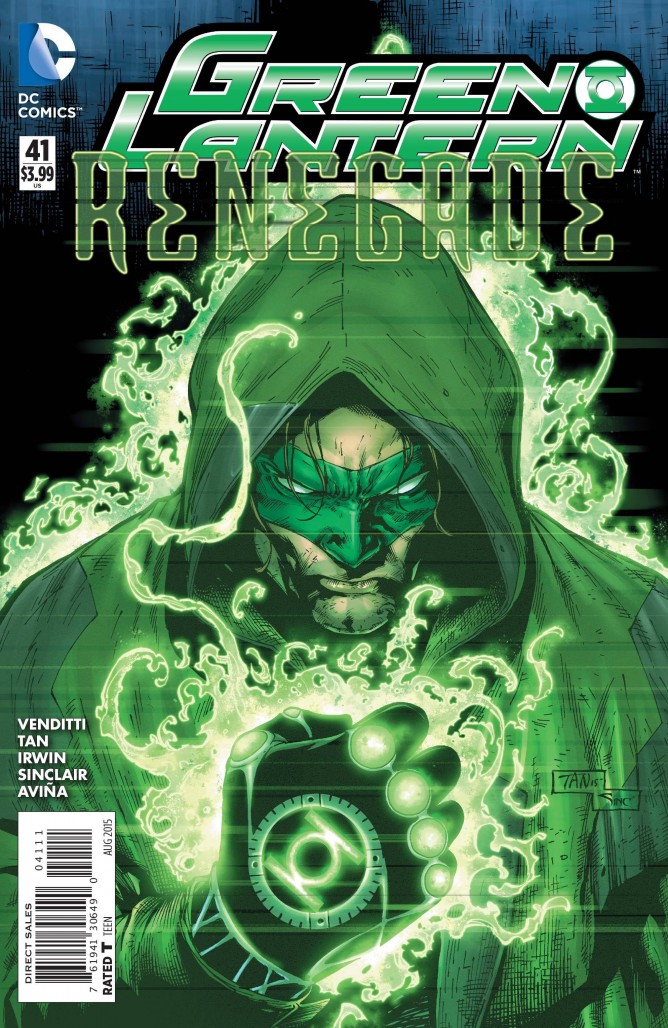One of these “strike while the iron is hot” deals. Or more accurately, strike when your brain feels like co-operating.
Last night, DC took the stage at this year’s Comics Pro meeting to talk about their upcoming Rebirth initiative, and was met with resounding murmurs from the internet. The reasons for this are plentiful, starting with the content and intent of Rebirth, and extending towards DC’s intended audience for this information.
The comic book industry has always had a portion of the audience that is deeply engaged with the behind the scenes mechanics that bring books to the stands. As such, when DC announces Rebirth to a room full of retailers, they also make sure that PR packets are sent out to various comic book news sites. In addition to that, they provided CBR with a bevy of exclusive talking points, in exchange for (I’m assuming) message compliance. The result is a boat of information points tailored for retailers floating out to sea the anchor severed. This was going to happen regardless of whether or not DC freely offered the information to comic news sites, so at the very least, they got to control part of the message. Unfortunately, the content of that message left a lot to be desired.
At this point, the company has solidified quite a few elements of Rebirth, including the make-up of their line, the intended shipping schedule, and a commitment to a $2.99 price point for books that are part of the core initiative. For retailers, this is all vital ordering information, and can be used to draw up a vague ordering structure in advance. Unfortunately, at this point, that’s not enough.
Over the past few years, retailers have been told not to trust what DC has to offer – the results of which can be seen in the company’s last year or so worth of releases. While some point to the last soft relaunch in June of last year as the biggest stumbling block, I would say retailer’s reaction to that line make-up was more cause than effect. The current form of the direct market is incredibly slow moving and resistant to change, and it will often take months or years for fundamental changes to take hold within the way books are produced or ordered. DC’s recent numbers are the result of general instability when it comes to the directions the company has tried to go in recent years. When The New 52 began, there seemed to be a plan. The creative map and line-up of books seemed quite a bit more daring than what had come before, and they wore that proudly. Then, just a few short months into the initiative, deep cracks began to form in the foundation. Creative teams started chaffing under specific directives. Ideas that had long been approved were scrapped and new road maps were drawn up. Books like Green Arrow burned through four different writers within the span of less than two years, while others featured similar (though less frequent) changes almost immediately. Ideas like Pandora were brought up, changed, or discarded. The line slowly moved from a place where there were several books offering a little something for everyone, to a violently reactionary core that plunged deep into regressive publishing tactics in order to retain a core, rather than gain new eyes. Simply put, retailers were told that they could not trust in a steadfast direction, so they started to order more cautiously.
Now, in order to combat that perception, the company is once again looking backwards to try and build back the audience that it squandered through similar tactics. Their only saving grace? They’re framing Rebirth much like they did The New 52, with the initiative announcement, followed by (one assumes) a gradual roll out of creative announcements. They’re also nabbing the phrase Rebirth from successful Geoff Johns of the past, in order to push the nostalgic money button that much harder. I should note, this isn’t a terrible idea, especially when you consider the fact that the company was taking this information directly to retailers. For the most part, retailers are a pretty regressive bunch, placing orders using the memory of what sold before, and pulling in the memories of things that made them money is always a good bet. That’s a good short term fix, but if this truly the backbone of this initiative, the company will be asking itself some very hard questions within 6 months, let alone a year.
Without further information, I have to assume that this whole initiative is more of the same – a hastily constructed fix to problems that need more forward thinking solutions than ones that look towards the past. Keywords offered in what little is out there include a focus on legacy and ensuring that the books function as parts of a larger universe. This paragraph from Geoff Johns in his CBR interview is particularly telling:
“If you look at Green Lantern: Rebirth or The Flash: Rebirth, absolutely it’s targeted to fans who’ve read a lot of comics. Who have as many comics as me. But at the same time, people can pick it up, and there’s enough in Green Lantern: Rebirth for someone to pick it up who has never read Green Lantern and understand what’s happening. With DC Universe: Rebirth, it’s the same thing. If you have, like me, long boxes of DC Comics, you will be very happy. If you’ve never read a DC comic before, you won’t be too lost. This is definitely for comic book readers more than it is for casual readers, just like Green Lantern: Rebirth, but that doesn’t mean it’s exclusive of them.”
While it’s great to be thinking of people who have been reading comics for a long time, it always seems weird to focus on that audience at the detriment of getting new eyes. Yes, I will admit that he is saying that they’re also trying to make the comics for casual readers as well, but I believe that’s more of a platitude than an actual goal. When a big part of your publishing initiative involves looking backwards to the past, focusing on legacy and shipping your core batch of titles twice a month, you are very clearly not aiming for casual readers even slightly. And again, I get why they wouldn’t: a casual reader isn’t where the money lies. As a retailer, I know this. The bread and butter of the comic book shop are the people who subscribe to comics, and come in at least once a week, to once a month to grab their books.
That said, I’ve been working on the front lines long enough to know that if you are only selling to your die hards, you will die one day. It will be slow, but it will happen, because eventually, everyone either has a shift in their life circumstances or priorities, whether that be a new house, a new kid, a waning sense of interest, or death. Having a line of books that can be used as an easy to access gateway is not only smart, but vital. I can’t tell you how many people I introduced the Marvel Universe to through Runaways many years before I even started selling comics for a living. I was doing the same thing with Prez, which I’ve used to get people into Batgirl and Gotham Academy, and now they’re looking for more in the DCU, but honestly… there’s not much for them there. I mean, could you imagine a Supergirl book penned by, say Noelle Stephenson? Can you imagine what sales would be for something like that? Probably relatively low in the direct market, because again – DC has done a great job of scaring off that audience and retailers as a group are slow moving to realize how much good having variety can do for a customer base, but that would be a well cast book. Left to its own devices, that’s a gateway to a new batch of readers – which will eventually add to the so called “comic readers” pool.
That all said… I want this to work for DC. I want them to surprise me, and put together something wonderful and cohesive, with titles that function on their own, are allowed to have their own identity, but work as parts of a whole. If they can pull that off, I think they have a solid shot at remaining healthy – but if they start plunging deep into deep pools of convolution, then they’re going to have a big problem, and soon. Luckily for me, the current slate of DC titles don’t sell too well for me (outside of Batman, Prez, and Batgirl) so if they crash, it’s not as though I was relying heavily on their content. But if they thrive… well, that’s going to be great for all of us.
ADDITIONALLY
This didn’t quite fit within the structure of the (admittedly structure-light) article, but I do have to say that DC opting for the rolling launch instead of the “all in one go” system that they used the last few times is probably the smartest, most forward thinking part of this entire initiative. It shows that they can learn from how smaller titles can and will get lost in the crush if they are placed alongside your double shipping core-hero titles. So kudos for that.
Until next time.










I wonder…
What if DC offered a discount to retailers…
Order the same amount of copies for the first six issues of a title (which would be a complete story arc, ready for bundling), and DC will add a higher discount.
AND… DC will also set variant ratios lower for these “subscribers”… maybe 1:20 instead of 1:25.
There was no messaging compliance agreement. Feel free to ask me directly next time — I’m always available and willing to talk!
On Prez: Looks like there will be a second miniseries after all, in September:
https://twitter.com/Manruss/status/700488890986070016?s=09
The all-at-once approach was the biggest missed opportunity of the New 52. When I first heard the sketchiest outline of that initiative, I thought it was brilliant… because I misunderstood what they were doing.
What I thought they were doing – and they should have done – was to roll out those 52 new #1’s one per week, for a year: Action Comics #1 the first week, Detective Comics #1 the second week, Sensation #1 the third week, and so on. This would give the new DCU a chance to grow slowly, more like the original did in its early years, starting with Supes, Bats, and Wondy as the founders. At this rate, readers could afford the time and money to pick up every single new series (or at least the ones that looked interesting to them), and give them a try. It would also be more manageable for editorial, compared to trying (unsuccessfully) to build an entire universe in a few months (in secret).
Meanwhile, for the sake of cashflow and customer retention, they would continue publishing the old series, but end one of them per week. A few would have to come to a hasty conclusion, but others would have anywhere from 2 to 12 months to tell one last story featuring the old-version characters, with all the stops pulled out. Think Crisis but without the crossover series. These would be the “Whatever Happened to the Man of Tomorrow”s of the current generation, and every fan who cared about the characters would want to stick around for them… and hopefully get drawn into the new DCU that they see dawning on the racks alongside them.
For retailers it would be less of a crapshoot ordering the new titles, because by the time the first dozen were out, they’d have actual sales history to base their orders on. And if DC was to market the new universe properly to new readers (for a change), retailers would have a year in which they’d have both old customers and new customers coming into their shops, each with something written for them. Some of the old-timers would probably leave when the last of “their” series ended (inevitable with a reboot), but – if the new creators did their job right launching the new series – not most of them, and not nearly as many as they would gain over a year of organically building a new universe and a new/renewed audience for them.
At least that’s how it all played out in my head, before I found out that The New 52 meant 52 #1’s all shipping the same month, and my heart sank.
P.S. I’m willing to move to L.A. to oversee this plan. ;)
Once creative teams are announced, that will be that. I can’t think of a better selling point than creative teams to retailers. Knowing WHAT you’re selling makes hand selling work.
The problem I had as a reader that with only a few exceptions, Lemire’s Green Arrow and Snyder’s Superheavy, none of these stories would have had much of a problem at all being adapted to the Pre-Flashpoint DC Universe. Instead of feeling like stories were adding, it felt much more like things were being taken away. My favorite character, J’onn J’onzz was no longer a founding member of the Justice League. Wally West is not the same character. It was baffling that a company that had spent decades telling me to invest in something and then pretty much irrevocably altered it without so much as trying to look like they care.
Now then, I continued to pick up anything written by Geoff Johns and Scott Snyder, but after awhile they were the only DC comics I was picking up besides Doctor Fate. I truly feel that Harras has really damaged the trust between fans and company, much like he did while at Marvel. The books where you can tell creators were allowed freedom from editorial interference, like Lemire’s Green Arrow, Snyder on Batman, Grant Morrison, Batgirl and Geoff Johns, were the best books on the stands. I’m hoping, really hoping that Geoff Johns is the key. Everything in his address really feels like he has been in editor-in-chief for the relaunch, which means letter creators do the books how they want. DC has one more chance to stick the landing and I really hope they do.
Comments are closed.